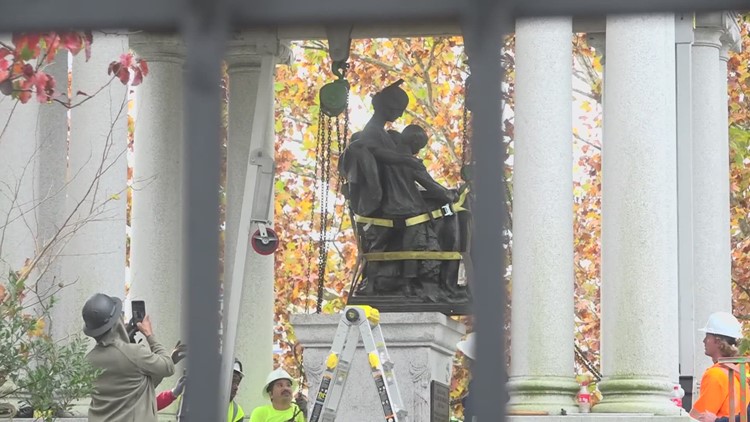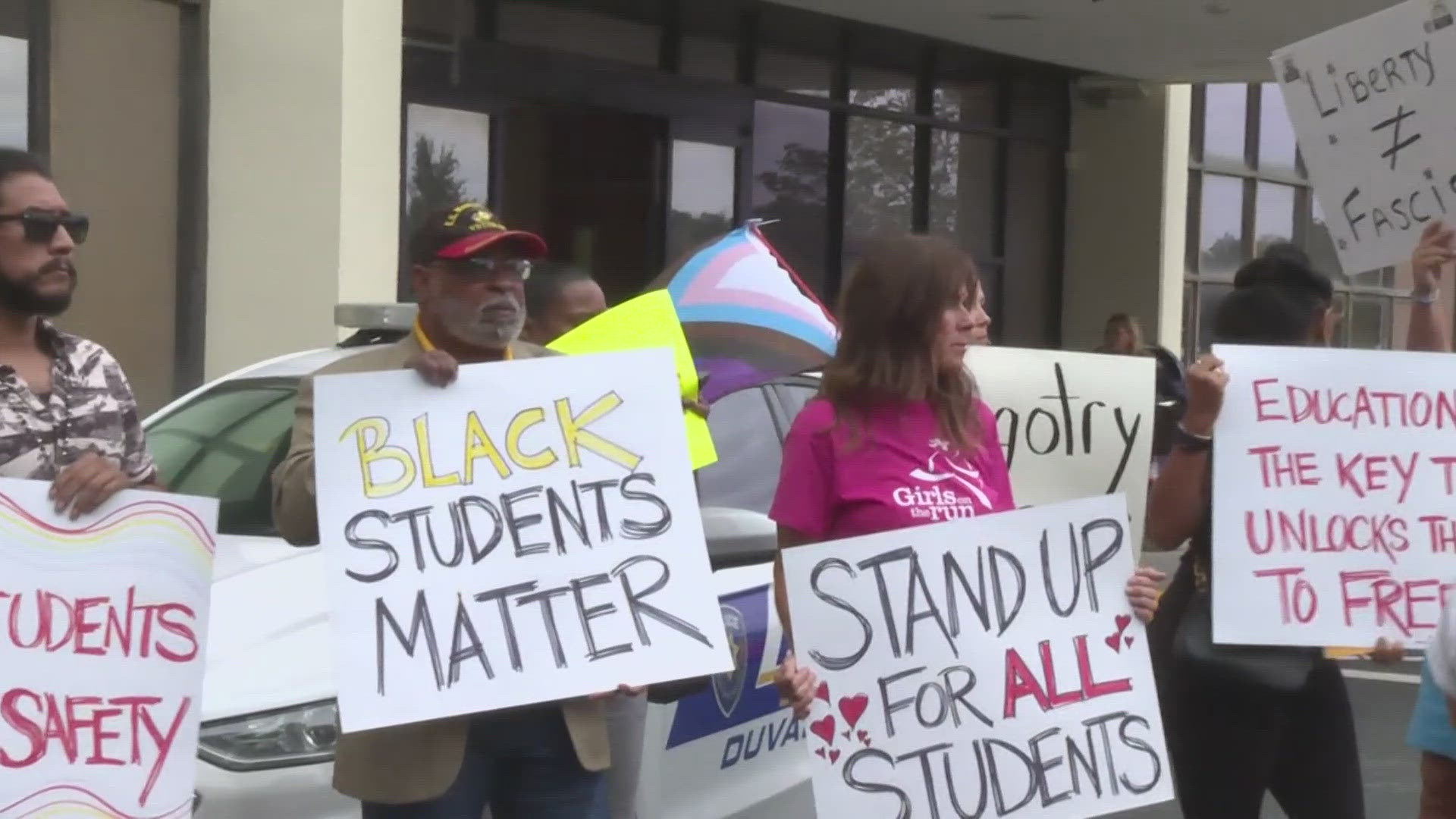JACKSONVILLE, Fla. — General Counsel Michael Fackler will go before City Council on Tuesday and explain his office's legal opinion on Mayor Donna Deegan's authority to remove statues from a Confederate monument in Springfield Park without seeking approval from City Council or obtaining a certificate of appropriateness from the Jacksonville Historic Preservation Commission.
Fackler was scheduled to explain his legal opinion to the Rules Committee of City Council at its meeting at 2 p.m. Tuesday.
The legal opinion has brought sharp debate within the Office of General Counsel about whether the Deegan administration needed a certificate of appropriateness for altering the monument because it is in the Springfield Historic District, according to emails obtained by the Times-Union through a public records request.
Known as the "Tribute to the Women of the Southern Confederacy" and as the "Women of the Southland" monument, the structure has stood in Springfield Park since 1915.
Deegan directed the removal on Dec. 27 of bronze statues portraying a woman holding a Confederate flag on top of the monument and a woman reading to two children inside it. The $187,000 to pay for taking down those statues came from the Jessie Ball duPont Fund and 904WARD, both Jacksonville nonprofit organizations and 904WARD contracted with ACON Construction for the work.
The legal issues involved in the removal of the statues have covered whether City Council must give its approval for such work when private money is used, and also whether the monument's location in the Springfield Historic District means it falls under certain protections in the city's ordinance code for historic preservation that would require the Jacksonville Historic Preservation Commission to sign off on any alterations to it.
As a group of attorneys was working with Fackler to hash out the legal issues this month, Senior Assistant General Counsel Jason Teal wrote in a Jan. 8 email to other attorneys that he completely disagrees with a conclusion that the monument does not fall under protections in the city's ordinance code for historic preservation.
The city created the Springfield Historic District in 1992, covering an area that includes the park, which used to be called Confederate Park. The district including the park also is on the National Register of Historic Places.
The application to the U.S. Department of the Interior in 1987 to designate Springfield neighborhood on the National Register of Historic Places describes the historic significance of the park. The application's list of "contributing properties" to the historic district includes the monument.
In arguing against a legal conclusion that the city's historic preservation requirements don't apply to the monument, Teal wrote in his email that "what is being overlooked and is unexplained" is that the actual address of Springfield Park is "separately and independently listed" on the list of contributing structures for the historic district.
"If you read the local historic designation application — which was accomplished by virtue of the submission of the National Register application documents as allowed by code — the significance of Springfield's parks, and their monuments, is clearly identified as contributing to the historic fabric of the area," Teal wrote.
He said the Confederate monument is "specifically and repeatedly referenced in the application documents as being an important part of the park, and a map of the Springfield historic district attached to the application "clearly depicts the monument and the other structures within the park as contributing structures."
He wrote that between 2007 and 2012, the city parks department applied for at least four certificates of appropriateness to do work at the park, including one certificate to clean and repair the Confederate monument.
Teal gave similar advice in July when he concluded any attempt to alter the Confederate monument would require the Deegan administration to apply for a certificate of appropriateness. The planning department's historic preservation section would evaluate the application and the Jacksonville Historic Preservation Commission would decide whether to issue the certificate. Any appeals of the preservation commission's decision would go to City Council.
Teal wrote in a draft legal memo "there are a number of public policy considerations" that could be used to justify issuing a certificate of appropriateness.
Teal wrote his legal memo while Bob Rhodes was serving as acting general counsel. Fackler, who became acting general counsel on Sept. 29 and was confirmed by City Council as general counsel on Dec. 12, took another look at the issue in December when he advised Deegan she could move forward with removing the statues by using privately-raised money to pay for that work.
Fackler worked with Assistant General Counsel Craig Feiser on draft legal memo in December that Fackler said was the basis for him giving his advise to Deegan.
That draft memo said "historical evidence suggests that the monument has not been designated as a 'contributing structure' to a historic district." The memo said that when City Council created the Springfield Historic District, the ordinance identified parks and monuments as '"significant characteristics" of the historic district but the ordinance "does not specifically list" the monument as a contributing structure to the historic district.
"Because the monument at issue here is not a historic monument, it is not entitled to special protections under the City Code, and even if it was so entitled, there is little recourse for the mayor exercising her executive authority over parks to remove the monument," the draft memo said. "In short, the mayor has executive authority to remove a monument from a city park."
City Council President Ron Salem and council member Nick Howland then asked Fackler to put his finding into an official opinion.
A draft advisory opinion circulated to Office of General Counsel attorneys on Jan. 11 says the monument arguably was not entitled to any unique protections because it was not identified in the historic district designation in the early 1990s.
But the draft opinion notes that the park's property address is listed in the designation of the historic district and the city's practice has been to treat the monument as covered by the requirements to get a certificate of appropriateness for any work or repairs done on the monument.
The draft opinion says if the monument is entitled to protections under the historic preservation and protection requirements in the city's ordinance code, including obtaining a certificate of appropriateness, "the questions remains whether there is a remedy" for removal of the statues without obtaining a certificate.
"The Planning and Development Department has discretion to enforce the provisions" of that part of the ordinance code and it is "highly unlikely that any individual would have standing to bring a cause of action" against the city for removing the statutes, the draft opinion said.
The draft opinion's conclusion says that while the "only question" regarding the removal of the statutes is whether Deegan should have obtained a certificate of appropriateness, the city's enforcement of that requirement "is discretionary and there can be no individual legal cause of action as a result of the removal."
The draft opinion is not a final opinion so the opinion that Fackler provides to City Council could be different from the draft version.



